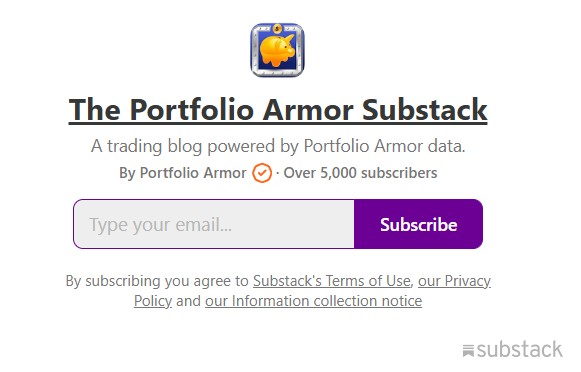
Be Fearful When Others Have FOMO
It’s natural to have some FOMO (Fear of missing out) after the rally we’ve had off the April lows. I have some myself. At the end of March, I guessed correctly that shares of Robinhood Markets (HOOD), a Portfolio Armor top ten name at the time, were probably near a bottom. As I wrote then, in a pre-market note, when the futures were a sea of red:
I’m lowering the strike on these HOOD puts by $2. This puts our break even on the stock at $34, which is about its 200-day exponential moving average, which seems like a plausible near-term bottom for it.
But instead of buying OTM (out of the money) calls on HOOD, I sold puts on it.
The stock is Robinhood Markets (HOOD 0.05%↑), which I think would be a great long term holding if we can get it in the $30s. So I placed a GTC order to sell the $38 strike put on it expiring on May 9th for $4. If that put gets exercised, I will have effectively bought the stock for $34. The max gain on one contract is $400, the max loss is $3,400 (assuming the put gets exercised, and then the stock goes to zero), and the break even is with HOOD at $34.
This trade hasn’t filled yet. This trade filled at $4.30 on 4/3/2025.
Avoiding FOMO And ROMO
I see shares of Robinhood trading in the low $60s now and realize I could have made ~2,000% buying OTM calls back then instead. Same with Palantir Technologies (PLTR), another PA top name at the time. I made some modest profits (~150% gains) on some relatively conservative options trades on it, but OTM calls on that would would be up >10x now too.
Maybe FOMO’s the wrong word for what I have. It’s more like ROMO (Regret of missing out). But some of you reading this probably do have FOMO, and are tempted to buy now.
So What To Do Now?
Be ready if there’s another leg down. Then you might get a chance to buy your favorite stock for less. Here’s why that might happen this summer.
Despite the bullish headlines this week—trade agreements, easing tensions between the U.S. and China, and market technicals pointing toward continued upward momentum—there’s still cause for concern.
First, Treasury bond yields remain elevated, signaling persistent concerns over inflation and higher-for-longer interest rates. Even with some positive trade news, bond investors seem skeptical that inflation has been beaten, or that the Fed will be quick to cut rates.
Secondly, the current U.S.-China trade deal includes only a temporary, 90-day suspension of new tariffs. The risk remains high that tensions could reignite, particularly if either side perceives a lack of follow-through on promised concessions. Markets have repeatedly underestimated the fragility of trade truces in the past, leading to sudden and sharp reversals.
Plus, economic damage from months of elevated tariffs and disrupted trade flows may already be baked in. Manufacturers, retailers, and global supply chains have absorbed significant costs and disruptions, which can continue to weigh on earnings and consumer spending even after an initial deal is struck.
Finally, valuations in major indices remain stretched relative to historical averages, leaving little room for error.
The Case For Bear Repellant
If you’re fully invested now, and we get another leg down in the market this summer, you won’t have any dry powder to buy beaten-down stocks with. If you take the opposite tack, and just stay in cash, you’ll have two other problems. First, FOMO may become irresistible. Second, if the market keeps going higher for the rest of the year–or longer–you’re going to miss out on all those gains.
A little bear repellant (hedging) goes a long way. One or two percent of your portfolio in option hedges can balloon to a sizeable position in a market crash. Your appreciated options will be dry powder you can convert to cash to buy stocks near the bottom. If you want an easy way to find optimal hedges, you can download the Portfolio Armor app by aiming your iPhone camera at the QR code below (or by tapping here, if you’re reading this on your phone).

And if you want to avoid ROMO with me next time, you can subscribe to the Portfolio Armor trading Substack/occasional email list below. Next time the market tanks, I’ll be swinging for the fences.
If you’d like to stay in touch
You can scan for optimal hedges for individual securities, find our current top ten names, and create hedged portfolios on our website. You can also follow Portfolio Armor on X here, or become a free subscriber to our trading Substack using the link below (we’re using that for our occasional emails now).

